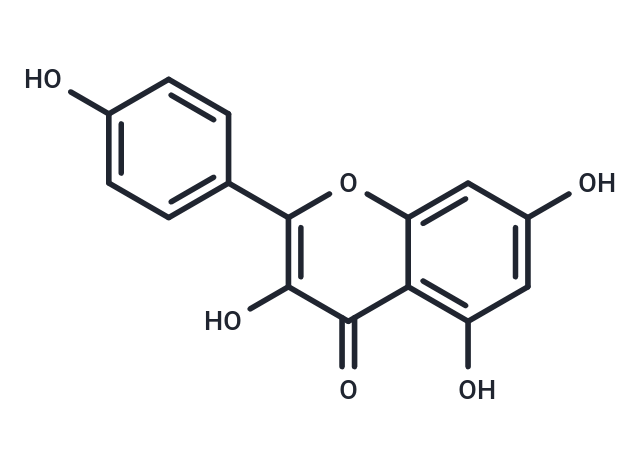Shopping Cart
- Remove All
 Your shopping cart is currently empty
Your shopping cart is currently empty

Kaempferol (Robigenin) is a natural flavonoid and an inverse agonist of ERRα and ERRγ. Kaempferol has a wide range of antitumor, anti-inflammatory, antioxidant, antibacterial and antiviral activities.

| Pack Size | Price | Availability | Quantity |
|---|---|---|---|
| 50 mg | $46 | In Stock | |
| 100 mg | $58 | In Stock | |
| 200 mg | $91 | In Stock | |
| 500 mg | $197 | In Stock | |
| 1 mL x 10 mM (in DMSO) | $50 | In Stock |
| Description | Kaempferol (Robigenin) is a natural flavonoid and an inverse agonist of ERRα and ERRγ. Kaempferol has a wide range of antitumor, anti-inflammatory, antioxidant, antibacterial and antiviral activities. |
| In vitro | METHODS: Human breast cancer cells MDA-MB-231 were treated with Kaempferol (0.01-100 μM) for 72 h, and cell viability was detected by MST assay. RESULTS: Kaempferol inhibited cell proliferation in a dose-dependent manner with an IC50 value of 43 μmol/L. [1] METHODS: Human gastric cancer cells AGS and SNU638 were treated with Kaempferol (50 μM) for 8-24 h. The expression levels of target proteins were detected by Western Blot. RESULTS: Kaempferol increased cleaved caspase-3 and -9 and decreased Bcl-2 levels in a time-dependent manner. [2] |
| In vivo | METHODS: To investigate the effects on hemorrhagic shock mice, Kaempferol (10 mg/kg) was administered intraperitoneally to C57/BL6 mice experiencing hemorrhagic shock. RESULTS: Pre-treatment of hemorrhagic shock mice with Kaempferol significantly reduced plasma TNF-α and IL-6 levels; restored MPO, SOD and MDA in the heart, lungs and liver; and increased HO-1 expression in the same organs. [3] METHODS: To study the anti-neuroinflammatory effects, Kaempferol (25-100 mg/kg) was administered by gavage to BALB/c mice once a day for seven days, and LPS (5 mg/kg) was injected on the seventh day. RESULTS: Kaempferol may be a promising neuroprotective agent to alleviate inflammatory responses and blood-brain barrier dysfunction by inhibiting HMGB1 release and downregulating the TLR4/MyD88 inflammatory pathway. [4] |
| Kinase Assay | Right atria or sinus nodal cells are homogenized in lysis buffer consisting of (50 mM Tris-HCl pH 7.5, 100 mM KCl, 1 mM ethylenediamine tetraacetic acid, 1 mM ethylene glycol tetraacetic acid, 1 mM dithiothreitol, 0.1 mM phenylmethylsulfonyl fluoride, 0.5 mM Benzamidine, 20 mg/L Leupeptin, 20 mM sodium pyrophosphate, 50 mM NaF, and 50 mM sodium β-glycerophosphate), and total protein content is determined by the Bradford assay. Caspase-3 activity is determined by EnzChek Caspase-3 Assay Kit[3]. |
| Cell Research | Kaempferol is prepared in DMSO (100 mM) and stored (-20°C), and then diluted with appropriate medium[2]. Ovarian cancer cells are seeded in 96-well plates at 2000 cells/well and incubated overnight before treatment with 0-160 μM Kaempferol for 24 hours in triplicates. The medium is removed, and the plates are freeze-thawed to lyse cells. Each well is added with 200 μL 1× CyQUANT cell lysis buffer containing 5x SYBR Green I and incubated at room temperature (RT) for 5 minutes. The reaction (50 μL) is transferred to PCR strip tubes and the fluorescent signal is measured at 90°C with a real-time Chromo4 PCR instrument. To ensure that cell proliferation assays are performed within a linear range of cell numbers, a standard curve is generated by seeding different amount of OVCAR-3 cells (based on counting with a hemacytometer) in a 96-well plate, and measuring genomic DNA abundance after overnight incubation. Three independent experiments are performed and data is pooled for statistical analysis[2]. |
| Alias | Robigenin, Kempferol |
| Molecular Weight | 286.24 |
| Formula | C15H10O6 |
| Cas No. | 520-18-3 |
| Storage | Powder: -20°C for 3 years | In solvent: -80°C for 1 year | Shipping with blue ice. | ||||||||||||||||||||||||||||||||||||||||
| Solubility Information | 10% DMSO+40% PEG300+5% Tween 80+45% Saline: 2.86 mg/mL (9.99 mM), Please add co-solvents sequentially, clarifying the solution as much as possible before adding the next one. Dissolve by heating and/or sonication if necessary. Working solution is recommended to be prepared and used immediately. H2O: < 1 mg/mL (insoluble or slightly soluble) Ethanol: 28.6 mg/mL (100 mM) DMSO: 45 mg/mL (157.21 mM) | ||||||||||||||||||||||||||||||||||||||||
Solution Preparation Table | |||||||||||||||||||||||||||||||||||||||||
10% DMSO+40% PEG300+5% Tween 80+45% Saline/Ethanol/DMSO
Ethanol/DMSO
| |||||||||||||||||||||||||||||||||||||||||

Copyright © 2015-2024 TargetMol Chemicals Inc. All Rights Reserved.